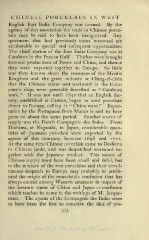Page 455 - Oriental Series Japan and China, Brinkly
P. 455
CHINESE PORCELAIN IN WEST
English East India Company was formed. By the
agency of this association the trade in Chinese porce-
lain may be said to have been inaugurated. Any
specimens that had previously come westward are
attributable to special and infrequent opportunities.
The chief station of the East India Company was at
Cambron in the Persian Gulf. Thither were brought
keramic productions of Persia and China, and thence
they were exported together to Europe. So little
was then known about the resources of the Middle
Kingdom and the great industry at Ching-te-chen
that the Chinese wares sent westward in the Com-
pany's ships were generally described as " Cambron
ware." It was not until 1 840 that an English fac-
tory, established at Canton, began to send porcelain
direct to Europe, calling it " China ware." Expor-
tation by the Portuguese from Macao is said to have
gone on about the same period. Another source of
supply was the Dutch Compagnie des Indes. From
Deshima, at Nagasaki, in Japan, considerable quan-
tities of Japanese porcelain were exported by the
agents of this company, between 1698 and 1722.
At the same time Chinese porcelain came to Deshima
in Chinese junks, and was despatched westward to-
gether with the Japanese product. This source of
Chinese supply must have been small and fitful, but
to the mixture of the two porcelains and their simul-
taneous despatch to Europe may probably be attrib-
uted the origin of the remarkable confusion that has
always existed among Western amateurs in respect of
the keramic wares of China and Japan confusion
which reaches its acme in the writings of M. Jacque-
mart. The agents of the Compagnie des Indes seem
to have been the first to conceive the idea of pro-
373

